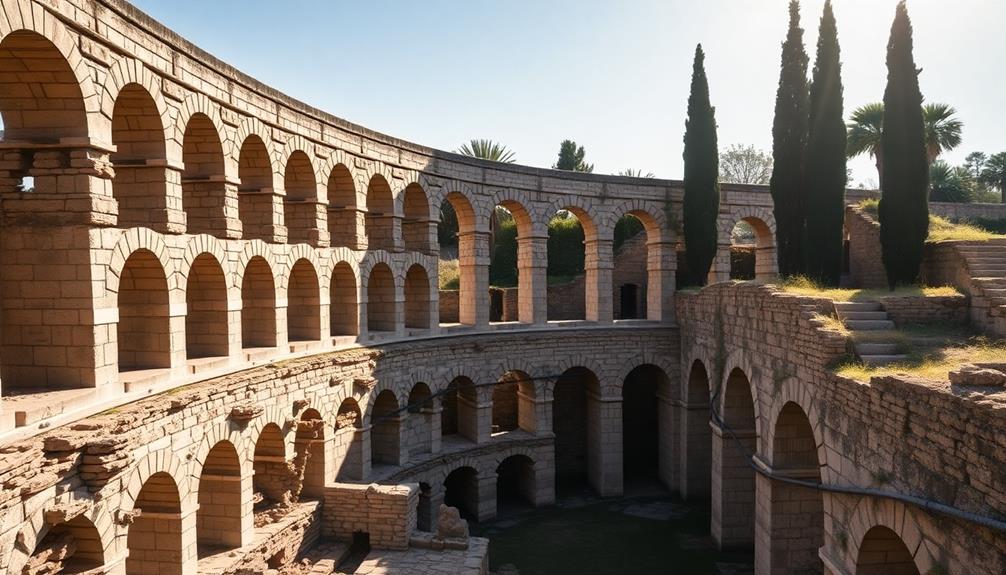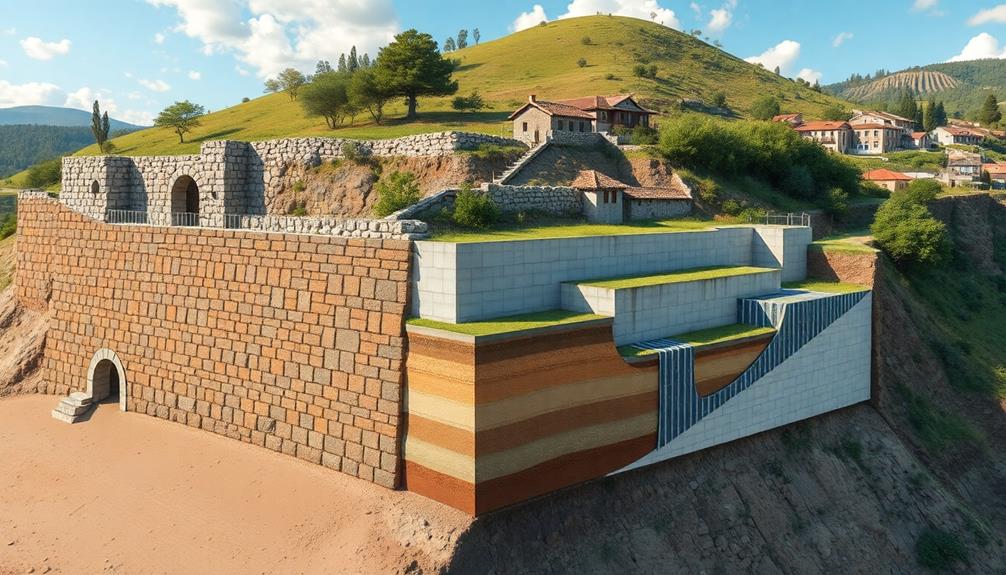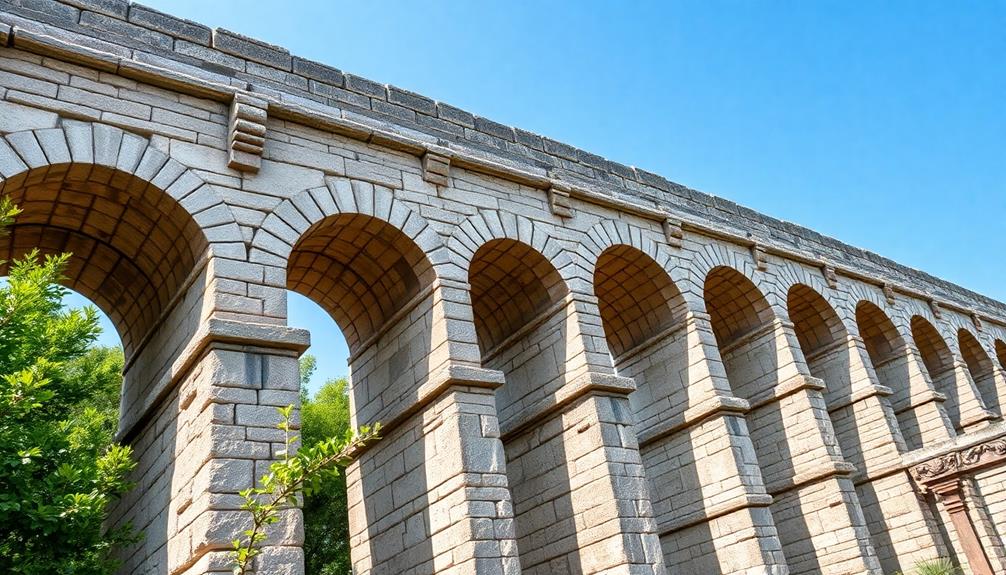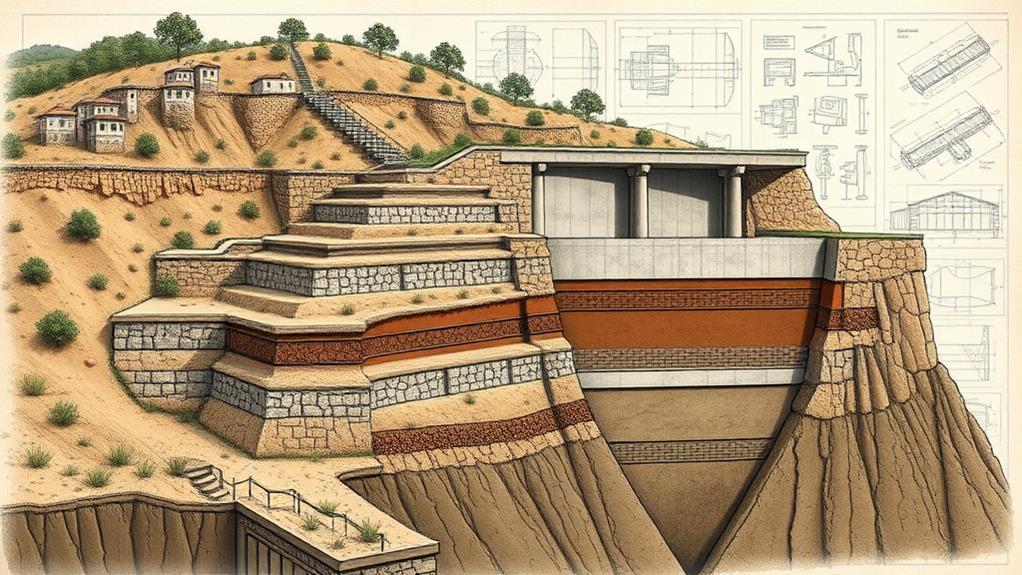The historical development of retaining wall engineering finds its roots in ancient Roman concrete structures, renowned for their durability and innovative design. Roman engineers pioneered the use of pozzolana cement, a mixture of volcanic ash and lime, which enhanced structural stability and longevity. Their innovative techniques included arches, vaults, and massive load-bearing walls, exemplified by iconic structures like aqueducts and the Pantheon. These ancient constructions showcased remarkable waterproofing methods, utilizing materials such as bitumen, lime mortar, and hydraulic concrete. The Romans' engineering prowess laid the foundation for modern retaining wall practices, influencing contemporary approaches to structural support, erosion control, and landscape improvement. Further exploration reveals the enduring impact of these ancient innovations.
Table of Contents
ToggleWalls Contractor Highlights
- Ancient Roman concrete structures pioneered durable retaining wall engineering using innovative pozzolana cement mixtures.
- The development of arch-based designs and vaulted ceilings enhanced load-bearing capabilities in retaining walls.
- Incorporation of volcanic ash and seawater in Roman concrete contributed to increased durability and self-healing properties.
- Waterproofing techniques like bitumen, lime mortar, and hydraulic concrete improved water resistance in retaining structures.
- Retaining walls evolved to serve multiple functions, including erosion control, structural support, and aesthetic landscape improvement.
Ancient Roman Concrete Structures

Ancient Roman concrete structures, particularly their retaining walls, have captivated engineers for centuries due to their remarkable durability and innovative design. The Romans' use of pozzolana cement, a mixture of volcanic ash and lime, revolutionized construction techniques and allowed for the creation of robust, long-lasting structures that have withstood the test of time.
Modern companies like Boulder Walls continue this tradition of building durable retaining walls, utilizing a range of materials and focusing on structural integrity to guarantee longevity. These engineering marvels incorporated structural innovations such as arches and vaults, which distributed weight more efficiently and enabled the Romans to build on an unprecedented scale, resulting in aqueducts, harbors, and massive retaining walls that continue to inspire modern civil engineering practices.
Pozzolana Cement Composition
The secret to the longevity of Roman concrete structures lies in their unique pozzolana cement composition. This remarkable material, derived from volcanic ash, was mixed with lime and seawater to create a durable, self-healing concrete that has withstood the test of time. The Romans' ingenious use of pozzolana cement revolutionized construction techniques, enabling the creation of monumental structures that continue to inspire engineers and architects today.
The pozzolana cement composition offers several advantages over modern Portland cement:
- Enhanced durability and resistance to weathering
- Ability to set underwater, ideal for marine structures
- Self-healing properties that repair micro-cracks over time
- Lower carbon footprint due to reduced limestone content
- Increased strength and flexibility in various environmental conditions
As members of the engineering community, we can draw valuable lessons from the Romans' mastery of concrete technology. By studying the composition and properties of pozzolana cement, we gain insights into developing more sustainable and resilient construction materials for future generations. This ancient innovation continues to shape our understanding of structural engineering and challenges us to push the boundaries of material science in our quest for superior building techniques.
Structural Design Innovations
How did Roman engineers translate their advanced concrete technology into groundbreaking structural designs? By harnessing the unique properties of their hydraulic cement, Roman architects and engineers revolutionized construction techniques, creating structures that have endured for millennia. The innovative use of pozzolana cement enabled the development of massive, load-bearing walls and vaulted ceilings that were previously impossible with traditional stone masonry.
Roman engineers pioneered the use of cofferdams, allowing them to build underwater foundations for bridges and harbors. They implemented arch-based designs in aqueducts, amphitheaters, and domes, distributing weight more efficiently than ever before. The Pantheon in Rome stands as an enduring legacy to their mastery, featuring a 43.3-meter unreinforced concrete dome that remained the world's largest for over 1,800 years.
These innovations facilitated the expansion of urban infrastructure throughout the empire, fostering a sense of shared cultural identity among diverse populations. The durability of Roman concrete structures, some still standing after two millennia, continues to inspire modern engineers and architects in their quest for sustainable and resilient building solutions.
Durability and Longevity
Why have Roman concrete structures endured for millennia while modern structures often deteriorate within decades? The answer lies in the remarkable composition and engineering techniques employed by ancient Roman builders. Their concrete, known as opus caementicium, possessed unique properties that contributed to its exceptional durability and longevity. This ancient material, composed of volcanic ash, lime, and seawater, underwent a chemical reaction that strengthened over time, particularly when exposed to seawater.
The enduring nature of Roman concrete structures can be attributed to several factors:
- Incorporation of volcanic ash, which enhanced chemical reactivity
- Use of seawater, facilitating the formation of mineral interlocks
- Slow curing process, allowing for more complete chemical reactions
- Absence of steel reinforcement, eliminating corrosion issues
- Flexibility in the material, reducing crack propagation
These characteristics resulted in structures that not only withstood the test of time but also improved with age. Modern engineers and materials scientists are now studying these ancient techniques to develop more sustainable and long-lasting building materials. By understanding and adapting the principles behind Roman concrete, we can potentially create structures that rival the longevity of their ancient counterparts, ensuring a more resilient built environment for future generations.
Benefits

Retaining walls offer a multitude of benefits that extend far beyond their primary function of soil retention. These structures notably enhance land utilization by creating level surfaces on sloped terrain, while simultaneously providing critical erosion and flood control in areas prone to environmental instability.
Boulder retaining walls are particularly effective in preventing erosion and creating usable areas for gardening, patios, and parking. They also serve as decorative extensions of homes, enhancing the overall aesthetic appeal of the property.
In addition, retaining walls serve as invaluable structural support elements in construction projects and contribute to aesthetic landscape improvements, transforming previously unusable spaces into visually appealing and functional environments.
Increased Land Utilization
One of the most significant advantages of retaining walls is their ability to dramatically increase land utilization. By effectively managing soil and terrain, these structures allow property owners to reclaim previously unusable areas and transform them into functional spaces. This optimization of land use has profound implications for both urban and rural development, enabling the creation of additional living spaces, recreational areas, and agricultural plots.
The increased land utilization afforded by retaining walls offers numerous benefits:
- Maximization of property value through the creation of usable terraces
- Enhanced safety by stabilizing slopes and preventing soil erosion
- Improved drainage management, reducing the risk of flooding and water damage
- Creation of aesthetic landscapes, incorporating multi-level gardens and outdoor living areas
- Facilitation of construction on challenging terrains, expanding development possibilities
As members of a community seeking to optimize our surroundings, we can appreciate the transformative impact of retaining walls on our shared spaces. These structures not only provide practical solutions for challenging topographies but also contribute to the overall enhancement of our built environment. By implementing retaining walls, we collectively participate in the efficient use of land resources, fostering sustainable development practices that benefit current and future generations.
Erosion and Flood Control
Environmental resilience is considerably enhanced through the implementation of retaining walls, particularly in their capacity for erosion and flood control. These structures play a pivotal role in safeguarding communities and landscapes against the destructive forces of nature. By stabilizing soil and redirecting water flow, retaining walls effectively mitigate the risks associated with erosion, which can lead to land degradation and property damage.
In flood-prone areas, retaining walls serve as indispensable barriers, containing rising water levels and preventing inundation of surrounding territories. This protective function is especially essential in urban settings, where the preservation of infrastructure and human habitation is paramount.
Furthermore, retaining walls contribute to the overall ecological balance by reducing sediment runoff into water bodies, thereby maintaining water quality and aquatic habitats. The engineering behind these structures has evolved to incorporate advanced materials and design techniques, enhancing their durability and effectiveness in combating environmental challenges. As climate change intensifies extreme weather events, the significance of retaining walls in erosion and flood control continues to grow, underscoring their importance in sustainable urban planning and environmental management strategies.
Structural Support Enhancement
Beyond their environmental applications, retaining walls offer significant benefits in structural support enhancement. These structures play an indispensable role in reinforcing and stabilizing various construction projects, providing essential support for both natural and built environments.
Retaining walls effectively distribute lateral earth pressures, enabling the creation of level surfaces on sloped terrain and maximizing usable space in challenging topographies.
The structural support benefits of retaining walls include:
- Increased land stability and prevention of soil movement
- Enhanced load-bearing capacity for adjacent structures
- Creation of additional usable space in sloped areas
- Reduction of hydrostatic pressure on foundations
- Improved drainage and groundwater management
Aesthetic Landscape Improvement
Retaining walls offer more than just structural support; they also provide substantial aesthetic benefits to landscapes. These engineered structures seamlessly integrate into outdoor environments, transforming barren slopes into visually appealing terraced gardens or creating elegant shifts between different ground levels. By incorporating various materials such as natural stone, brick, or textured concrete, retaining walls can complement existing architectural styles and enhance the overall visual harmony of a property.
The aesthetic value of retaining walls extends beyond their immediate appearance. They create opportunities for innovative landscaping designs, allowing property owners to maximize usable space and introduce diverse plant life. Tiered retaining walls can serve as focal points, showcasing cascading florals or ornamental shrubs that add depth and interest to otherwise flat terrain. Additionally, these structures can be designed to incorporate built-in seating areas, water features, or lighting elements, further elevating the functionality and ambiance of outdoor spaces.
As retaining wall engineering has evolved, the integration of aesthetic considerations has become increasingly sophisticated, resulting in structures that not only fulfill their primary structural purpose but also contribute significantly to the beauty and value of the surrounding landscape.
Waterproofing Techniques in Ancient Rome

Ancient Romans employed sophisticated waterproofing techniques in their retaining wall construction, demonstrating remarkable engineering prowess. Their methods included the use of bitumen and lime mortar, lead sheet waterproofing, and hydraulic concrete applications, each serving specific purposes in protecting structures from water damage. The following table outlines key aspects of these waterproofing techniques, highlighting their composition, primary applications, and notable characteristics:
| Technique | Composition | Primary Applications | Durability | Water Resistance |
|---|---|---|---|---|
| Bitumen and Lime Mortar | Natural asphalt, lime | Foundations, cisterns | High | Excellent |
| Lead Sheet Waterproofing | Thin lead sheets | Roofs, aqueducts | Very High | Superior |
| Hydraulic Concrete | Volcanic ash, lime, aggregate | Harbors, dams | Exceptional | Outstanding |
| Opus Signinum | Crushed terracotta, lime mortar | Floors, water tanks | High | Very Good |
| Cocciopesto | Lime, crushed brick, pozzolana | Wall coatings, baths | Moderate | Good |
Bitumen and Lime Mortar
Waterproofing techniques in ancient Rome showcased remarkable ingenuity, with bitumen and lime mortar playing pivotal roles in protecting structures from moisture damage. The Romans developed sophisticated methods to guarantee the longevity of their architectural marvels, utilizing these materials to create impermeable barriers against water infiltration.
Bitumen, a naturally occurring hydrocarbon substance, was applied as a waterproof coating on various surfaces, while lime mortar served as both a binding agent and a sealant in construction.
The effectiveness of these ancient waterproofing techniques is evident in the following key aspects:
- Durability: Structures treated with bitumen and lime mortar have withstood the test of time
- Versatility: These materials were employed in a wide range of applications, from aqueducts to foundations
- Chemical stability: Both bitumen and lime mortar exhibit resistance to degradation over extended periods
- Adaptability: The Romans refined these techniques to suit diverse environmental conditions
- Legacy: Modern waterproofing methods still draw inspiration from these ancient practices
The implementation of bitumen and lime mortar in Roman construction exemplifies the advanced engineering capabilities of our predecessors. By studying and adapting these time-tested techniques, we continue to build upon the rich heritage of architectural innovation that connects us to our shared history.
Lead Sheet Waterproofing
Renowned for their innovative engineering solutions, the Romans also employed lead sheets as an effective waterproofing technique in their construction projects. This method, developed to combat moisture infiltration in structures, particularly retaining walls, demonstrated the Romans' advanced understanding of material properties and their practical application in civil engineering.
The process involved carefully layering thin lead sheets over the surface to be protected, typically stone or concrete. These malleable sheets were meticulously fitted and sealed to create a continuous, impermeable barrier against water ingress. The Romans recognized lead's resistance to corrosion and its ability to withstand environmental stresses, making it an ideal choice for long-term waterproofing solutions.
In retaining wall construction, lead sheet waterproofing played an indispensable role in preserving structural integrity and preventing water-induced degradation. By effectively managing hydrostatic pressure and moisture migration, this technique greatly extended the lifespan of retaining walls, contributing to the durability and longevity of Roman engineering marvels. The implementation of lead sheet waterproofing exemplifies the Romans' commitment to innovative problem-solving and their profound impact on the evolution of construction methodologies.
Hydraulic Concrete Applications
Roman engineers revolutionized construction practices with their development of hydraulic concrete, a groundbreaking material that enhanced waterproofing capabilities in ancient structures. This innovative mixture, composed of lime, volcanic ash, and aggregate, possessed remarkable properties that allowed it to set and harden underwater.
The application of hydraulic concrete in retaining walls and other water-resistant structures marked a significant advancement in engineering techniques, enabling the construction of more durable and resilient edifices.
The use of hydraulic concrete in ancient Rome offered several advantages:
- Improved structural integrity in aquatic environments
- Enhanced resistance to water penetration and erosion
- Increased longevity of structures exposed to moisture
- Greater flexibility in architectural design and construction
- Reduced maintenance requirements compared to traditional materials
The implementation of hydraulic concrete in retaining walls provided superior protection against water ingress, effectively mitigating the risk of structural failure due to hydrostatic pressure. This technological breakthrough allowed Roman engineers to construct more ambitious projects, including aqueducts, harbors, and coastal fortifications. The legacy of hydraulic concrete applications in ancient Rome continues to influence modern engineering practices, serving as an enduring legacy of the ingenuity and foresight of our predecessors in the field of civil engineering.
Walls Contractor FAQ
How Did Ancient Civilizations Before Rome Construct Retaining Walls?
Ancient civilizations before Rome constructed retaining walls using various methods. They employed dry stone techniques, stacking rocks without mortar, and utilized earthen embankments reinforced with wood or reeds. These structures helped manage terrain and protect settlements from erosion.
What Modern Technologies Have Revolutionized Retaining Wall Design and Construction?
Modern retaining wall design and construction have been revolutionized by advanced computer modeling, geosynthetic reinforcement materials, mechanically stabilized earth systems, and automated equipment. These innovations have enhanced safety, efficiency, and sustainability in our shared built environment.
How Do Soil Types Affect Retaining Wall Engineering and Stability?
Soil types notably influence retaining wall engineering and stability. Cohesive soils offer better support, while granular soils may require additional reinforcement. Understanding soil properties is vital for our team to design safe, durable structures that meet community needs.
What Are the Environmental Impacts of Large-Scale Retaining Wall Projects?
Large-scale retaining wall projects can dramatically impact ecosystems. They may alter natural drainage patterns, disrupt wildlife habitats, and increase erosion. However, when designed thoughtfully, these structures can also stabilize slopes and prevent landslides, benefiting our communities.
How Do Engineers Calculate the Load-Bearing Capacity of Retaining Walls?
Engineers calculate retaining wall load-bearing capacity through soil mechanics principles, considering factors like wall height, soil properties, and surcharge loads. They utilize methods such as Rankine's theory and Coulomb's theory to determine lateral earth pressures and overall stability.







